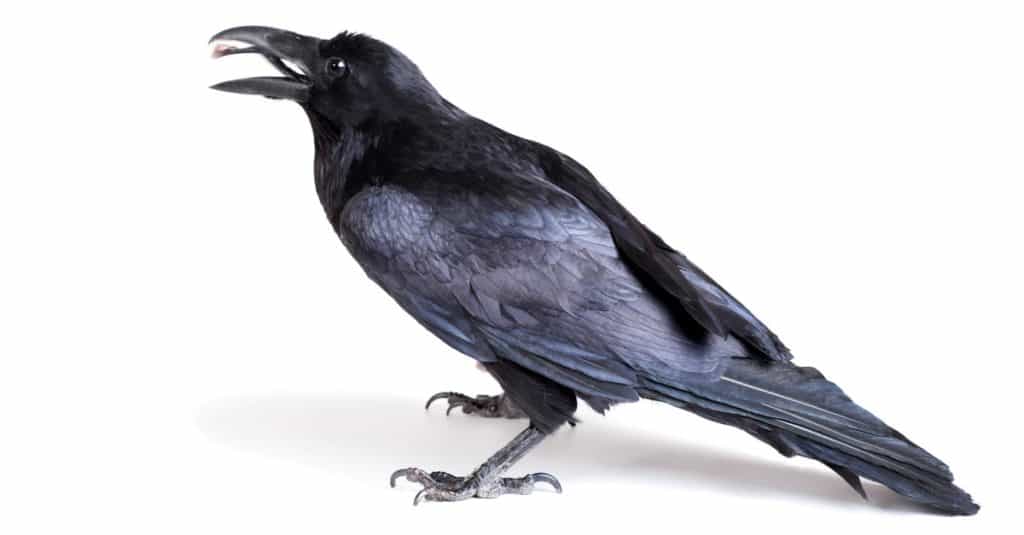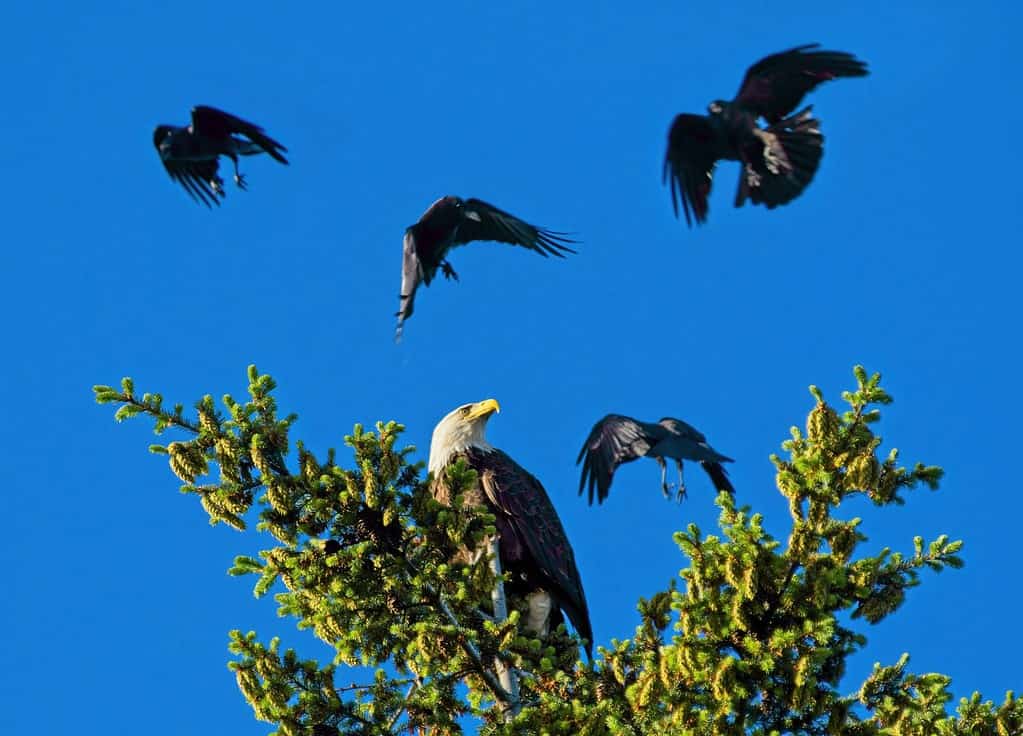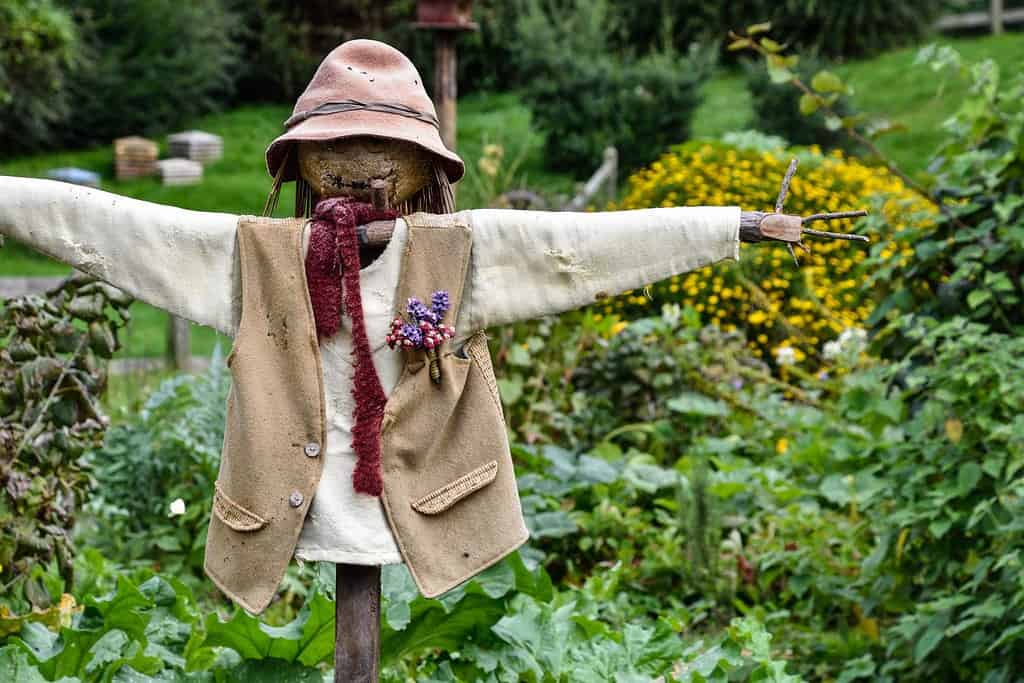There aren’t too many people who say crows are their favorite bird. These big, noisy birds raid crops, steal other species’ eggs and chicks, and even swipe shiny objects like coins, jewelry, or keys. Some people also find them spooky due to their dark color and unnerving cawing. Over the years, though, research has shown that they are highly intelligent birds with a complex social life that includes mating for life. In this article, you’ll discover the love lives of crows and some other amazing facts about these loyal birds.
1. Crows Are Big, Black, and Beautiful

The American crow is a beautiful jet-black bird with an iridescent sheen.
©del13/Shutterstock.com
Crows belong to the family Corvidae, along with ravens, magpies, and jays. They look similar to ravens but are not the same. The common raven (corvus corax) is much larger: about the size of a red-tailed hawk with up to a 5 ft (1.5 m) wingspan. The American crow is closer in size to a pigeon. Its wingspan maxes out at 3.3 ft (1 m). Crows are solid birds with long legs and straight bills. Their feathers, bill, legs, and feet are all black. The feathers on their upper back glisten in an opalescent way in the sunlight.
2. Crows Live Almost Everywhere

The common raven (
Corvus corax), is the most widespread member of the Corvidae family.
©Rosa Jay/Shutterstock.com
There are about 48 species of crows and ravens in the world living on every continent except Antarctica. The range of the American crow includes all of southern Canada, the lower 48 United States, and northern Mexico. The common raven is the most widespread of all species of Corvidae. It lives in most of the Northern Hemisphere from the Arctic south to Central America, North Africa, and Central Asia. Crows have an enormous population and are adaptable to many different habitats. As a result, they are considered a species of “Least Concern” when it comes to conservation. Crows will be with us long after many other species go extinct.
3. “Eating Crow” is a Cultural Thing
In the Western world, there’s a huge stigma against eating crows. They’re seen as being similar to rats and buzzards: animals that feed on garbage and carrion, and thus are disease-bearers. This is where we get the expression “to eat crow,” meaning to endure humiliation by admitting your mistakes, much like the humiliation of eating an inedible bird. There is validity to this concern. According to the National Institutes of Health, crows can spread pathogens that cause disease in humans and animals. They are still a traditional delicacy in some parts of the world, however, including Lithuania. Those who have literally “eaten crow” say it tastes a bit like wild duck.
4. Crows Are Highly Intelligent

These crows are harassing a bewildered eagle, perhaps hoping to make the large bird drop its prey.
©pr2is/Shutterstock.com
Crows are devious and cunning. They often come up with clever plans to steal food. In one example, a crow pecked at a river otter’s tail to distract it, while a group of other crows flew down and stole a fish from the animal. Experiments have shown that crows can make rule-guided decisions, engage in abstract thinking, understand analogies, create and use tools, exercise self-control, and seem to have an innate sense of numbers.
Recent research shows crows might even be capable of recursion: embedding structures in other, similar structures. It’s one of the ways humans build language. Take for example the sentence: “The crow flew away.” With a recursive element, this sentence might become: “The crow the cat chased flew away.” Previously, only humans and monkeys were thought to have the ability to understand recursive sequences.
5. Crows Mate for Life, With Exceptions
During mating season, male crows show off for females by dive bombing from the highest branches of a tree, not unlike teenage boys showing off on a pool diving board. When male crows court, they sing a song of soft coos, growls, and rattles, unlike their usual harsh cawing. Males do some dancing footwork and bow to their prospective mate and may bring females a gift of food. After the lady crow chooses a mate, the two nuzzle one another and start their family. Crows have three to nine chicks a year. It takes about two years for them to reach sexual maturity. Family groups of about 15 stay together, with the juveniles helping to take care of new chicks before striking out on their own.
Most crows mate for life and can live up to 15 years. However, if their mate is injured, they might mate with a different partner while still remaining bonded to the first one. DNA shows that about 18% of all crow broods come from a different partner. Infrequently it happens that a couple breaks up because they are infertile together. They go on to find new life partners. Older birds, however, will stay together regardless of their fertility status. If a mate dies, the survivor will seek a new mate.
6. Crows Have “Funerals” For Their Dead

A crow “funeral” might actually be a learning activity to enhance survival.
©Belmin Mesanovic/Shutterstock.com
Imagine the plot of a scary movie. The heroine hears a loud “thump” on her windowpane. She screams! There on the windowsill is a dead crow that crashed into the window. Then she hears the uncanny cawing of hundreds of crows flying in from every direction, landing on the tree outside.
What our terrified protagonist experienced was a crow funeral, and it’s a real thing. When a crow dies, a hundred or more of its family and friends gather around, not disturbing the dead body, but witnessing it. Why do they do it? It might be a survival strategy. The crows are scoping out the area to try to understand what killed their friend, so the same thing doesn’t happen to them. After this, crows may be reluctant to revisit the area, even if there is plenty of food available.
7. How Can You Scare Off, or Attract, Crows?

Gardeners don’t like crows raiding their produce. A traditional scarecrow is only a temporary fix.
©Kritsana Laroque/Shutterstock.com
Scaring Off Crows
The stereotypical “scarecrow” does indeed scare off crows, at least for a little while. But these intelligent birds soon figure out they are in no danger. Likely, they will use them as convenient roosts to survey the garden and decide what to steal next. If you want to keep crows away, you’ll have to add elements of noise, motion, and unpredictability. Objects that spin or flap in the wind, like pinwheels or flags, can scare them off. Though they like picking up small shiny objects, reflective moving things freak them out. Try stringing up discarded CDs or aluminum pie pans around your garden to move in the breeze. You could also play recordings of crow distress calls, although that means you’ll be hearing the sound of crows when you go outside.
Attracting Crows

When crows understand you are not a threat, they may become quite bold in taking offered food.
©Smiler99/Shutterstock.com
But what if you’ve grown to appreciate crows and would like to see more of them up close? How could you attract crows? Try things like providing them with a bird bath, leaving small stationary shiny objects on fence posts or other visible spots, keeping your cats indoors, and even putting out fake crows to make them feel welcome. Some foods crows eat are peanuts, walnuts, almonds, popcorn, fruit, eggs, meat scraps, and dry dog or cat food. If you sit outside very still and offer crows food, you might find they even bring you a shiny little gift now and then. If you’re patient enough, one of them might even bring you a diamond ring.
The photo featured at the top of this post is © Kavi fdo/Shutterstock.com
Thank you for reading! Have some feedback for us? Contact the AZ Animals editorial team.






